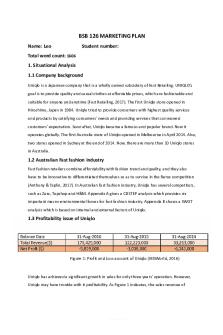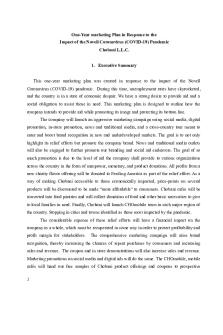Marketing Plan Final - Grade: A- PDF

| Title | Marketing Plan Final - Grade: A- |
|---|---|
| Author | Nimrah Zubairy |
| Course | Principles of Marketing |
| Institution | Institute of Business Administration |
| Pages | 48 |
| File Size | 1.2 MB |
| File Type | |
| Total Downloads | 84 |
| Total Views | 200 |
Summary
Download Marketing Plan Final - Grade: A- PDF
Description
Running Head: MARKETING PLAN: TIM HORTONS PRE-PACKAGED SALADS
Marketing Plan: Tim Hortons Pre-Packaged Salads Date: November 28, 2012 Authors: Mitchell Reisler - 0662093 Taylor Warren – 0678774 Brett Davis - 0636525 Sofia Pacione - 0627118 Stefano Incardona – 0719309 To: Tim Hortons Marketing and Advertising Executive Team and Professor O’leary
Executive Summary
Marketing Plan: Tim Hortons – Pre-packaged Salads
1
The quick-service restaurant is a highly competitive market, in which Tim Hortons leads the market in Canada. Tim Hortons has maintained a leadership position in the breakfas daypart and late night snacking market, but has been experiencing less than desirable sales in regards to their lunch time daypart menu, falling second to their key competitor, McDonalds. Tim Hortons has developed a new lunch time product, pre-packaged salads, which is meant to meet the demands of the health conscious psychographics and gain a competitive advantage in the lunchtime market. By doing this, Tim Hortons will lead in each of the four dayparts. In order for Tim Hortons to achieve this goal, small and large pre-packaged salads will be available at all locations across Canada. The in store pre-packaged salads will bebe located next to the cashier, in a clearly visible refrigerated display unit. Further, in order to continue differentiating from competitors, a lower price-point of $5.99, to coincide with Tim Hortons position will be implemented. In addition to this, to promote this new product, a marketing mix that will be implemented over the next year including, print advertising (Globe and Mail), outdoor advertising (Billboards and Drive-thru screens), viral videos and a national television commercial. This will cost approximately $13M over a one years span. All of the strategies will be implemented throughout the year with a heavy emphasis on the first six months of the launch. Further, the market will be targeted using a market penetration strategy in order to steal customers from McDonalds and further increase market share in the lunch daypart segment. Through analysis of the competition and analyzing the current and potential customers, Tim Hortons can succeed achieve their overall objective to increase market share by 10%.
Table of Contents Executive Summary..........................................................................................................................1
Marketing Plan: Tim Hortons – Pre-packaged Salads
2
Table of Contents..............................................................................................................................2 Introduction.......................................................................................................................................4 Situation Analysis - Internal.............................................................................................................4 Company Analysis:.......................................................................................................................4 Company Objectives and Marketing Objectives:.........................................................................5 Company Resources:....................................................................................................................5 Present Target Market:..................................................................................................................6 Current Marketing Mix:................................................................................................................6 Marketing Collaborators – Current and Potential Stakeholders:..................................................9 Situation Analysis – External..........................................................................................................10 Industry Analysis............................................................................................................................12 Market Analysis:.........................................................................................................................12 Market Size.................................................................................................................................12 Market Forecast:.........................................................................................................................12 Power of Suppliers:.....................................................................................................................13 Power of Customers:...................................................................................................................13 Existing Rivalry:.........................................................................................................................13 Power of Substitutes:..................................................................................................................14 Threat of New Entrants:..............................................................................................................14 SWOT Analysis..............................................................................................................................15 Strengths:....................................................................................................................................15 Weaknesses:................................................................................................................................15 Opportunities:.............................................................................................................................16 Threats:.......................................................................................................................................16 Key Success and Risk Factors:...................................................................................................17 Competitor Analysis.......................................................................................................................18 Identify Competitive Scope:.......................................................................................................18 Key Competitors’ Current Marketing Objectives and Strategies:..............................................19 Key Competitor Strengths and Weaknesses, Objectives, Strategies, and Future:......................20 Consumer Analysis.........................................................................................................................21 Who Buys the Product................................................................................................................21 Benefits and How They Use It....................................................................................................22 Where Consumers Buy...............................................................................................................22 When Consumers Buy................................................................................................................22 How Consumers Choose.............................................................................................................23 Why Consumers Prefer a Product...............................................................................................23 Will They Buy it? (Again)..........................................................................................................24 Proposed Marketing Plan................................................................................................................24 Marketing Strategies, Objectives, Goals....................................................................................24 Product Strategies, Objectives, Goals.........................................................................................25 Target Market..............................................................................................................................26 The target market to be used for the implementation of this marketing plan, and the end consumer of the new product being implemented is:.................................................................26 Marketing Mix............................................................................................................................26 Implementation and Control...........................................................................................................30 Potential Problems and Concerns...............................................................................................30 Action Plan.................................................................................................................................31
Marketing Plan: Tim Hortons – Pre-packaged Salads
3
Contingency Plan........................................................................................................................31 Market and Product Sales Potential:...........................................................................................32 Market and Product Sales Forecast:...........................................................................................32 Forecasted COGS:......................................................................................................................33 Pro-Forma Analysis:...................................................................................................................33 Appendix.........................................................................................................................................35 1 – Tim Hortons Income Statement............................................................................................35 2 – Tim Hortons Store Locations................................................................................................35 3 – Porter Industry Analysis.......................................................................................................36 4 – Second Cup Income Statement.............................................................................................38 5 – Levels of Competition..........................................................................................................39 6 – Perceptual Maps....................................................................................................................40 7 – Value Chain Analysis - McDonalds......................................................................................42 8 – McDonalds Strengths and Weaknesses.................................................................................42 9 – Media Schedule and Cost.....................................................................................................43 10 – Pro Forma Analysis.............................................................................................................44 References.......................................................................................................................................45
Introduction
Marketing Plan: Tim Hortons – Pre-packaged Salads
4
Throughout this report, a marketing plan will be developed for the implementation of a new Tim Hortons lunchtime product, pre-packaged salads. This plan will be based on analysis prepared in regards to all influential components affecting the success of the marketing plan. This includes an internal and external analysis, analysis of the industry Tim Hortons is in, the Quick Serve Restaurant industry, a review of competitors, and an analysis of current and potential consumers.
Situation Analysis - Internal Company Analysis: Tim Hortons has several organizational challenges they are faced with, including maintaining their dominant presence in the Canadian market, competition in the QSR market, and the challenges associated with expansion into the US. Tim Hortons will focus on growing their lunchtime daypart share, expand into new markets, and provide new products for potential, and current customers. With the combination of the growing trends, Tim Hortons can effectively maintain their dominant presence, and brand recognition in Canada, while continuing to use their strong brand name to become a leading competitor in the American market. The historical operating performance of the leading quick-service restaurant, Tim Hortons, shows that from 2009 to 2010 revenue increased from $2,438.9million to $2,536.5m with a total net revenue increase of 4.0%. 1From 2010 to 2011 the revenue increased to $2,835.0million2 This shows that
1Tim Hortons inc.. (01 J). Retrieved from http://annualreport.timhortons.com/downloads/full-ar.pdf 2Company., t. (n.d.). Form 10-K. Tim Hortons 2011 Annual Report. Retrieved October 27, 2012, from http://annualreport.timhortons.com/downloads/xmrl/form-10K.htm#tx269152_20
Marketing Plan: Tim Hortons – Pre-packaged Salads
5
although there is current global economic instability, Tim Hortons has been able to maintain a growing profit, and market share. Refer to exhibit 1 in the appendix for further details. Company Objectives and Marketing Objectives: Tim Hortons overall mission and vision is to be a leader in everything they do. This includes providing superior quality, products, and services to all of their stakeholders, including consumers, communities, partners, and employees3. Tim Hortons corporate goals moving in the near future include attacking the daypart segment, investing to grow the brand in new and existing markets, and leveraging core business strengths4. They currently use a growth objective in that they are always looking to be leaders in the market, and thus are always looking to grow their market share. Company Resources: Tim Hortons can be broken down into several functioning departments that contribute to the success: construction and restaurant design; distribution; finance and taxation; information technology; legal; marketing and corporate, public and Government affairs; operations; real estate and research and development. The combined efforts of the individual departments allows Tim Hortons to continuously increase their revenue and maintain their highly recognized brand. Tim Hortons has integrated “Tim Hortons University” to train all staff, and owners about the business. Tim Hortons University is a seven-week intensive program that includes subjects on how to properly and efficiently manage a franchise location.
3Tim Hortons inc.. (01 J). Retrieved from http://annualreport.timhortons.com/downloads/full-ar.pdf 4
(2010). Investor conference . More than a great brand, Retrieved from http://www.timhortons.com/ca/pdf/2010_Investor_Conference_FINAL.pdf
Marketing Plan: Tim Hortons – Pre-packaged Salads
6
Present Target Market: Tim Hortons mass markets across all demographics, psychographics, and geographic locations across Canada. They do this because of the low price, convenient products they offer. To be more specific, however, their demographics can be broken down per percentage of sales. This includes 18% ages 25-34, 20% ages 35-44 and 18% 45-54. Further, studies have found that Generation Y and Generation X demographics tend to spend more money per meal at quick-serve restaurants. 5The target psychographic are from a smaller household and empty nesters, as When an individual they will typically spend more money per visit than those from a larger household. Another psychographic characteristic used to define their demographic is being a worker, or being short on time. This is because of the convenience factor that Tim Hortons is known for, and provides. The geographic target market is nation-wide and spans across cities of all sizes. 6 Current Marketing Mix: Price The average cheque size of a Tim Hortons order in Canada and the U.S.A is between $2.75 to $3.50, with no 2-hour period of any day accounting for more than 20% of total daily sales1. Tim Hortons provides an every-day value pricing strategy, which means their prices fall below the average price offered from main competitors, McDonald’s, and Starbucks2. This pricing strategy provides Tim Hortons the opportunity to maximize customer satisfaction by providing an equal quality product, in comparison to competitors, for a lower price. Further, by
5 Frisch, E. (n.d.). Restaurant Equipment and Supplies. Demographics for Restaurants . Retrieved October 27, 2012, from www.foodservicewarehouse.com/restaurant-equipment-supply-marketingarticles/restaurant-marketing/demographics-for-restaurants/c28060.aspx 6 Company., t. (n.d.). Form 10-K. Tim Hortons 2011 Annual Report. Retrieved October 27, 2012, from http://annualreport.timhortons.com/downloads/xmrl/form-10K.htm#tx269152_20
Marketing Plan: Tim Hortons – Pre-packaged Salads
7
attracting customers covering all demographics, based on the price and quality offered, they are able to maximize profits maintain loyalty. Promotion Tim Hortons uses a promotion strategy that result in an increase in brand loyalty, and repeat purchases. Tim Horton’s achieves this by implementing promotions that focus on advertising specific products, combinations, or by offering free products at next purchase. Further, the central theme behind their promotion strategy is also their differentiating aspects, an organization that offers high quality products, at reasonable prices. With the integrated use of radio, television, online advertising, and event sponsorship, as well as highly visible community care programs, Tim’s is able to build their brand image, and market their promotions effectively. Tim Hortons spends approximately 3.5% of Canadian restaurant sales on their advertising budget7. One of their biggest expenditures is roll-up-the-Rim, in which Tim’s makes around 285,000,000 cups, distributed evenly through all Canadian provinces and territories, and 13 States, starting in February, and ending in March8. The prizes that are available in this promotion require repeat purchases, such as a free coffee, or donut upon next order. On top of singular promotions, Tim Hortons also schedules their promotion strategy within certain seasons or major events, such as using Sidney Crosby as an endorsement during the winter Olympics. Product Tim Hortons menu consists of a variety of products including premium coffee, hot and cold beverages, breakfast sandwiches, value snacks, and home-style soups, sandwiches, and wraps. Each restaurant contains a standardized menu, which includes a broad range of products 7Company., t. (n.d.). Form 10-K. Tim Hortons 2011 Annual Report. Retrieved October 27, 2012, from http://annualreport.timhortons.com/downloads/xmrl/form-10K.htm#tx269152_20
8 Liu, K. (2012, February 23). Coffe Shop - Contest Index. The Grid, p. 1. Retrieved November 23, 2012, from http://www.thegridto.com/life/food-drink/coffee-shop%E2%80%93contest-index/
Marketing Plan: Tim Hortons – Pre-packaged Salads
8
for various times throughout the day in order to appeal to customers all day long. In order to remind customer’s of the variety, and freshness of their products, Tim Hortons has recently undergone a layout transformation in which their bagels, and donuts moved from the behind the cashier, to the front, beside, the cashier. All product packages contain the Tim Hortons logo, and slogan, which is “Always Fresh” to further remind customers of their quality products. In addition, the packaging they use for their products are easy and convenient, which supplements the position they want to hold in their customers mind, a high-quality, reasonably priced store, that offers convenience and fast, efficient, service. In 2012, Tim Hortons Canadian advertising fund will invest up to $100 million to expand the use of digital menu boards, and drive-through rotating menu boards, in order to display the value the products provide, and the variety of products provided.9 Place Tim Hortons distributes their products to their customers through three channels: Standard, non-standard, and co-branded restaurants. Standard rest...
Similar Free PDFs

Marketing Plan Final - Grade: A-
- 48 Pages

Marketing Plan - Grade: 6
- 11 Pages

Chobani Marketing Plan Final
- 18 Pages

MKG5321 - Plan marketing final
- 35 Pages

Final Marketing PLAN
- 33 Pages

BSB126 Marketing Plan (Final)
- 10 Pages

Marketing Plan Final - framework
- 53 Pages

Capstone marketing plan (final)
- 14 Pages

BSB126 Marketing Plan - Grade: 6
- 17 Pages

BSB126 Marketing Plan - Grade 6
- 12 Pages

Global- Marketing - Grade: A+
- 30 Pages

MKT 361 Final Marketing Plan
- 13 Pages

PLAN DE Marketing Trabajo Final
- 15 Pages

Marketing PLAN ROSE Candle Final
- 80 Pages

PLAN DE Marketing Trabajo Final
- 16 Pages
Popular Institutions
- Tinajero National High School - Annex
- Politeknik Caltex Riau
- Yokohama City University
- SGT University
- University of Al-Qadisiyah
- Divine Word College of Vigan
- Techniek College Rotterdam
- Universidade de Santiago
- Universiti Teknologi MARA Cawangan Johor Kampus Pasir Gudang
- Poltekkes Kemenkes Yogyakarta
- Baguio City National High School
- Colegio san marcos
- preparatoria uno
- Centro de Bachillerato Tecnológico Industrial y de Servicios No. 107
- Dalian Maritime University
- Quang Trung Secondary School
- Colegio Tecnológico en Informática
- Corporación Regional de Educación Superior
- Grupo CEDVA
- Dar Al Uloom University
- Centro de Estudios Preuniversitarios de la Universidad Nacional de Ingeniería
- 上智大学
- Aakash International School, Nuna Majara
- San Felipe Neri Catholic School
- Kang Chiao International School - New Taipei City
- Misamis Occidental National High School
- Institución Educativa Escuela Normal Juan Ladrilleros
- Kolehiyo ng Pantukan
- Batanes State College
- Instituto Continental
- Sekolah Menengah Kejuruan Kesehatan Kaltara (Tarakan)
- Colegio de La Inmaculada Concepcion - Cebu
